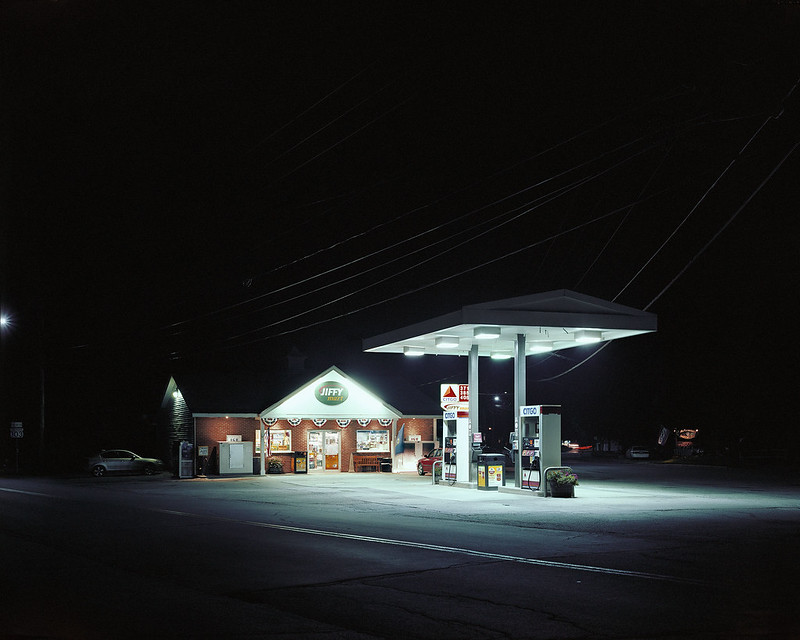
I would like to thank Professor William Granara (CMES) and Professor Gareth Doherty (GSD) for inviting me to discuss my nighttime photographs. And I would like to thank Professor Anita Berrizbeitia for introducing my work to them. It's exciting to be here with so many great speakers as well. I also very much appreciated the photography and video we've already seen.
While the these photographs are mostly from the Hudson River Valley north of New York City, and other points in the Southern and Western U.S., I hope to bring out some themes that will be useful for the larger discussion. I will discuss some of the pleasures of actually being outside at night which these photographs attempt to capture. I will also discuss themes of the built environment, the electrically lit environment, energy consumption, architectural re-appropriation, and night time activities of the denizens of these pictures. And there are some ideas about poetics which I'll try to bring out as we look at some pictures. Some of the places we've discussed so far are urban and very densely populated, in these pictures we see areas that are not only sub-urban or rural, but areas that are undergoing further de-population.
Originally while I had a few ideas worked out for this series with small digital files, I found making a satisfactory print impossible. The experience of standing in the places I found was not very well re-created with a small digital print. I had to go back in time to the large format cameras of earlier decades to find something that could capture the massive amount of detail necessary to make an absorbing print. With the 4 feet by 5 feet prints that I make, your eye can travel through the print, as your eye normally travels when you're standing somewhere. You can look closely at details by stepping towards the print or of course step back and view the whole scene. It helps give them an immersive feel.
By way of introduction, imagine that you have been inside for a while, working, say, and a point comes when you or someone needs something from the convenience store. To some people it would be a chore, but to you it would be a pleasure. A quick walk, or drive is a chance to take a break and get some fresh air. Once outside, you have a larger perspective on what you were working on, or maybe you even drop thinking about it totally. You notice the details of your environment, as in this picture. maybe something about the pavement, or the sound of a car up the way, or a maybe a joke about some kind of extreme packaging that some marketeer saw fit for a jiffy mart, or that the wires overhead come together like the prow of a ship.
The day was filled with goals to be achieved and concerns to be handled, but now that night has fallen people begin to put away those specific concerns until tomorrow. You have more mental freedom to think about what you want to think about.
It's still early. Here the viewpoint is looking east into the total dark of night, but --
-- back in the car driving west one can still see the end of twilight outlining the trees. Here I've been struck by the way the light creates a space for the building just under the treeline and the sky. I circle back and pull over to see about a composition. I walk around with a small digital camera taking snapshots from various angles, and in this case settle on a point of view similar to how I first saw it. I start setting up the large camera, and as I'm doing this, a breeze delivers my scent to a dog who starts barking. There are two houses nearby, and this area is clearly well watched.
The garage here has not been used for a while now. Grasses are retaking the parking lot. They show the yellowing color of the drier later summer. But the light still comes on every night, paid for by someone, and it's enough to signal to anyone that they probably shouldn't mess with the place. The light catches bits of glass in the gravel and reaches out to the edge of the road. Without the light, there would only be sky and the silhouettes of the trees. In a sense, there are two overlapping but distinct elements: there's the built environment, and then there's the lit environment.
As twilight turns into darkness, the sky and treeline disappear, and with them the sense of the space beyond the current scene. The lit environment now hangs in a more abstract darkness.
The facade of the building is nearly flat and lit with a cool white light. Above, two squares pierce that plane, and show a warm, reddish interior. An old television and an exercise bicycle sit by the open windows. Light catches some asphalt on the main road as well as three cables overhead which all link to the larger world of people. Still the darkness around isolates the scene.
Night is one of the great metaphors, and malleability, indeterminacy, and interiority are some of it's main qualities. I'm going to point out another quality, the blank page. I think of the way this collection of rectangles and shapes and colors sit as a kind of glyph or letterform in this abstract darkness. This idea of a letterform hanging in an indeterminate space is probably one of the main points that I think of in almost every photograph in this series.
The greenish lamplight catches the evergreen tree right in the middle of the composition. An old car is reverentially below as if the two together form the upper and lower parts a totem. In between these two parts is a pathway to a passage through the dark horizontal berm of a railroad track that extends the width of the picture. There's a sculptural quality to this formation. it's a kind of knot of collisions that comes forward form the general streetscape.
I think here of the Wallace Stevens poem Anecdote of the Jar. In it, a jar in the middle of a blank wilderness in Tennessee organizes the space around it. Often if I'm finding a composition, and I notice any resonances with that poem, it's a good sign.
Just after finishing the photograph, a freight train came rushing by with its piercing whistle.
Here we have a gas station with the minimal number of architectural elements possible, while still being a gas station. It's on a minimal piece of land as well, not at a major intersection, or on-ramp, or in a town.
And still, there's many kinds of energy represented. There's electrical energy being spent. There's the energy in the wires overhead being spent in other places. Gas energy is stored in the tank. There's the energy of implied moving cars. There's the energy of the implied photographer's car. There's the energy that pressed those tracks in the dirt. And there's the construction energy spent clearing the area, placing those concrete blocks, and building these structures.
There's another form of energy which isn't really knowable from the picture, although the "Pit Stop" logo mounted on the shed is a clue. This is a filling station for a drag racing speedway just to the west. On summer weekends several hundred people gather to drag race. They camp out in RVs; their kids run around in packs; and everyone enjoys the 30 second roar of the engines as each race goes off. In between races, you can hear a loudspeaker crackle with information.
Large amounts of fuel are consumed for no other reason than to race for fun. This car culture is a pleasure, a pleasure maybe shared by some but forced on others. I can't speculate about the family dynamics of these weekenders.
And this area away from the main action is legible as a place where those packs of kids might spend time, doing tricks on bicycles, throwing things, talking, and playing out other teenage dramas. It's not so far from a scene in the 1993 film Dazed and Confused, or the Led Zeppelin song by the same name.
I began sketching out ideas that eventually became this series about ten years ago. Two friends and I would go for walks or drives with a little 2MP camera finding visual ideas and trying to out-do one another. We were all writers at the time, and various fragments we'd find would be a kind of present day archeological object from which we would construct implied narratives. The built environment would provide us with clues about people who lived there and their intentions, foibles, accidents, and characters. A few years ago, I was reviewing these sketches with another friend who suggested I make printed photographs out of the ideas. In a sense I might be one of the characters wandering through a scene like this.
Here someone reads on the screened-in porch of a cabin in the woods in South Carolina. The foliage is thick and is piling up on the roof. The woods seem to be slowly swallowing the building.
In a picture with a figure smaller than a certain size, the landscape stays a landscape. Once the figure gets to be larger than a certain size, and subtleties of expression and body language and clothes will start to out-pace interest in the landscape or background. Even at this scale, while the picture remains a landscape, the figure still draws in the viewer.
Here, the lit environment and built environment are quite different in extent and look, though not totally distinct.
I'd like to go on to another major theme, architectural re-appropriation. In the U.S. there are several construction booms behind us. Nowadays, we're as likely to be interested in a well executed re-purposing or re-use as an original building.
Sometimes, in research, I take to google streetview, to get an idea of what pictures I might find in a given area. And in this case I had heard about an interesting part of the San Francisco Bay area.
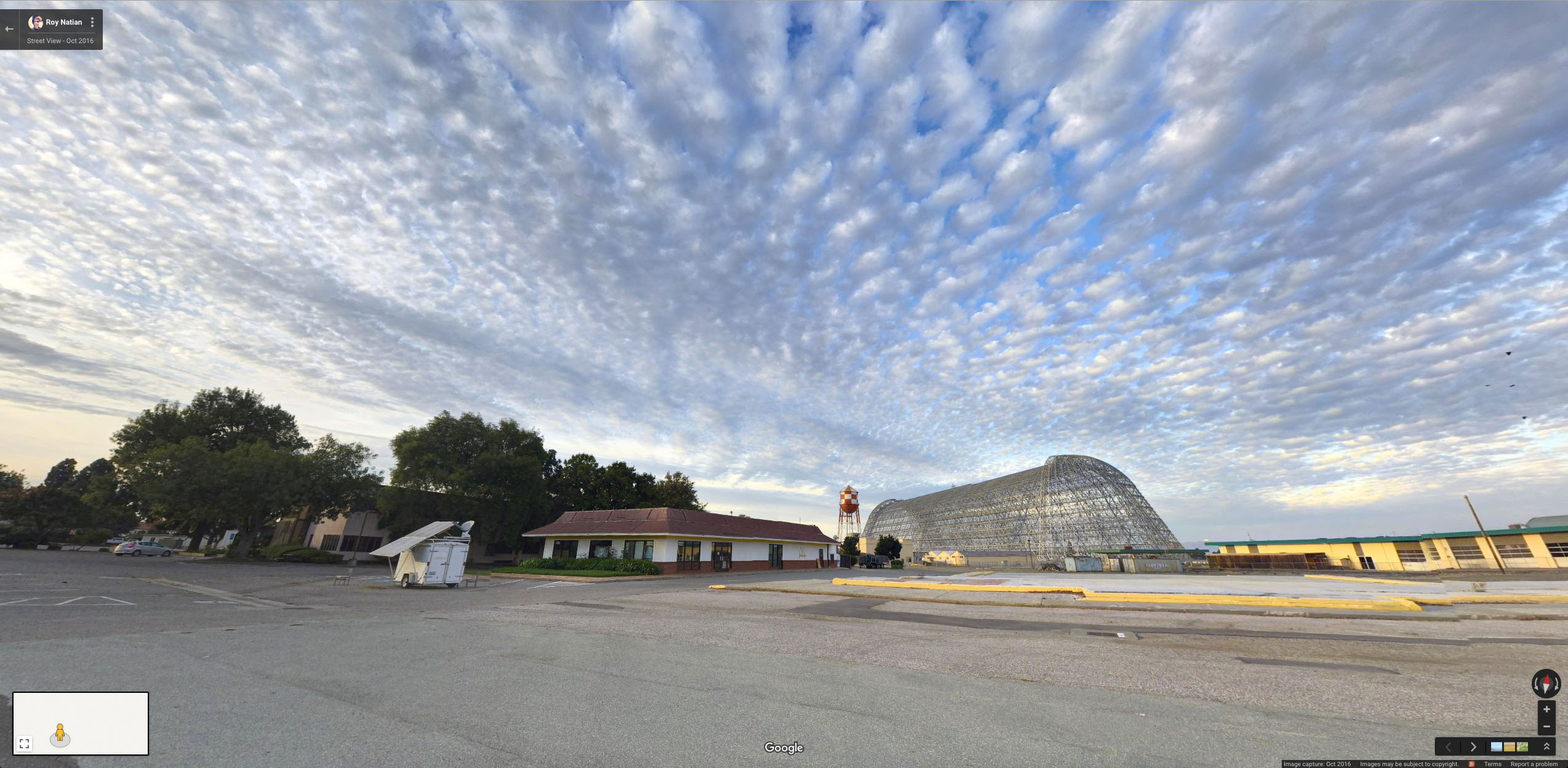
This isn't streetview exactly. I think the google car was not allowed in this area, but someone posted a 360 degree sphere which is viewable in a similar way to streetview. I read about this McDonald's having been taken over by some retired NASA scientists and others. They decided to re-activate an old satellite abandoned by NASA in the 1970s. Funded with crowdfunding, this Mcdonald's is now their mission control.
You can see their pirate flag in the window. And you can see the remnants of where those signature McDonald's light bars used to be on the roof.
To the right is Hangar One, originally built in 1931 to house zeppelins, by 1965 it was already a museum. Now Google is paying 20 million a year to lease the hangar from the government. They're currently in the process of remediating toxic chemicals. As it's right along the San Francisco bay, the more limited space, makes repurposing a more realistic option. Something in this area is a possible future project, but architectural repurposing is all over.
Here in North Carolina, an old gas station is now a payday loans place. The canopy once over the gas pumps now sits there with a looser purpose. It's geometries still work well juxtaposed with the road, yellow lines, and electrical wires. Behind and to the left you can see the blur of a passing freight train. The off-angle of the building which used to suggest the speed of cars, now suggests the quickness of the cash that might be had there.
Places like this are normally seen as predatory, as I saw it at first, but a book by Lisa Servon says there's more to it. Her initial hypothesis is that people who are living with very little money, are usually very aware of how every bit is spent. She found that the larger banks don't operate at the speed and risk level that places like this can operate. For example, a landscaping company in the spring will be making investments for customers much faster than customers are likely to pay back. A large bank is geared for established businesses that already have their own cash reserves. Once I found that out, the nature of the irony I thought I saw changed.
There's a further question of reading a landscape. I'm often thinking of what would be legible to a viewer of the print, from obvious to subtle but noticeable on extended viewing to impossible to know without outside information. In this case new information after the fact affected the print: finding out more about payday loans places lifted some, but not all, of the more nefarious weights in this picture. I also think of legibility not just in terms of information, but sensations as well. To find a viewer who mentions a sensation that I too had experienced can be a helpful confirmation.
This gas station has recently gone out of business. The stonework on the little shop building was part of a branding effort of perhaps 20 or 30 years ago. A truck driver has pulled over to sleep. On the right is a nearly full moon providing the cool white light and the blueness in the sky. On the left is an orange street light. As cars approach, their headlights pass through bushes, trees, and roadsigns building up the pattern of shadows on the white plywood over the door. As each car passes, it adds a little more light to the building and the camera's negative. Just before the car enters the frame, I close the shutter so as to avoid any light streak in the frame. I re-open the shutter after it has passed by. The light from cars coming in from the right also shine on the station and reflect off the metal.
The road has two sides: the passersby and the roadside building. For the passerby, the windshield and the side windows can become a kind of cinematic screen, and the roadside is in motion, and framed by the car window. Architects of those buildings sometimes try to colonize that screen of the passing car. Sometimes a simple neon sign will do.
Here is another flash as if from the left window.
This idea of a moving view from a moving vehicle idea probably goes quite far back.
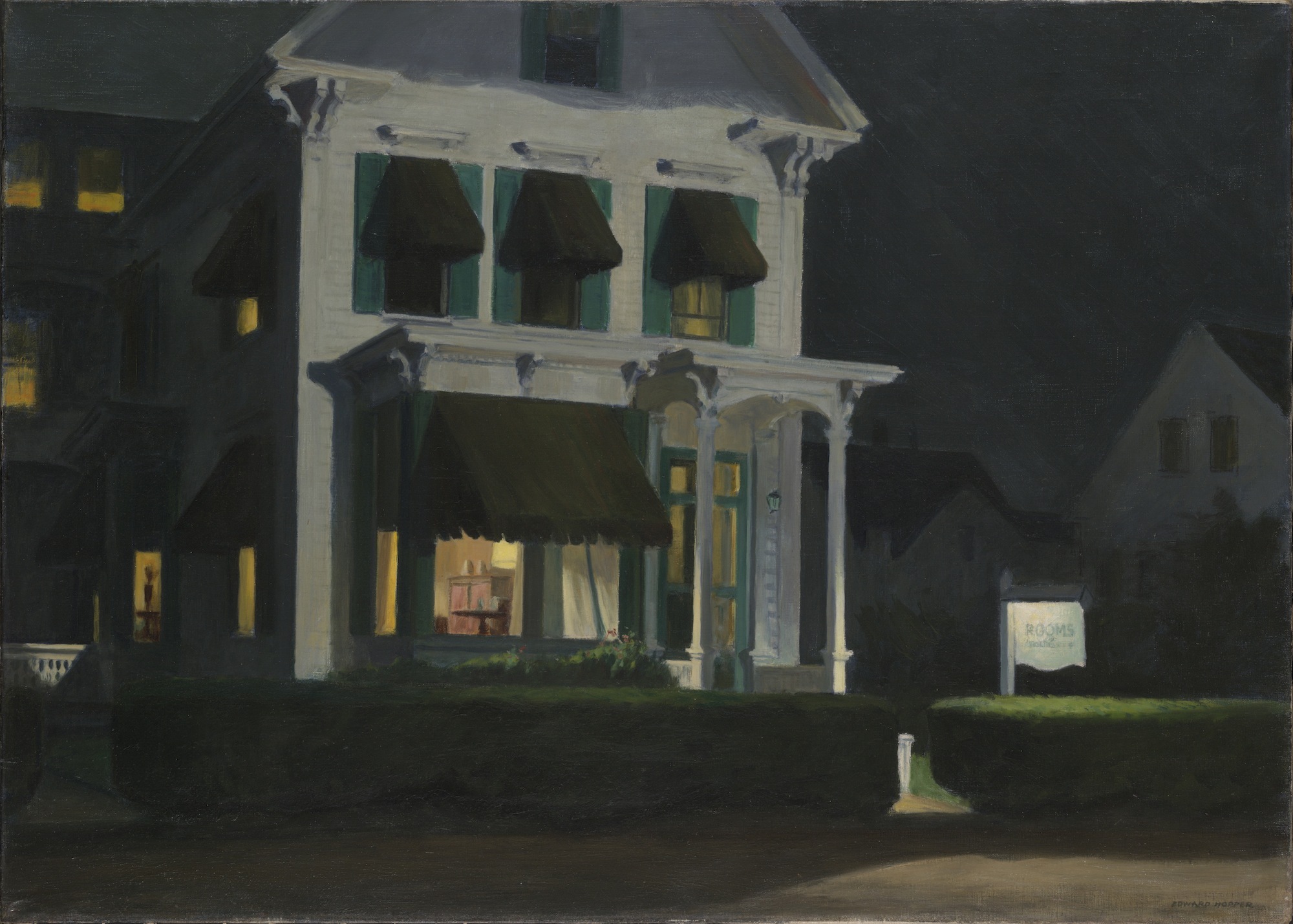 Edward Hopper first took to this idea when riding the elevated train in New York. He describes the train windows as giant screens, and after catching various sights from those screens, sketching them from memory. He went on to make several paintings looking in the upper windows of city buildings.
Later he would use a car as a tool in that same moving screen like way. Once he found a view he liked, he would make sketches and watercolors for possible paintings. In this painting, you can sense the open car window — the ceiling of the car just above the painting and the sill of the window just below. Here, it seems likely he was sketching while sitting in the drivers seat.
Edward Hopper first took to this idea when riding the elevated train in New York. He describes the train windows as giant screens, and after catching various sights from those screens, sketching them from memory. He went on to make several paintings looking in the upper windows of city buildings.
Later he would use a car as a tool in that same moving screen like way. Once he found a view he liked, he would make sketches and watercolors for possible paintings. In this painting, you can sense the open car window — the ceiling of the car just above the painting and the sill of the window just below. Here, it seems likely he was sketching while sitting in the drivers seat.
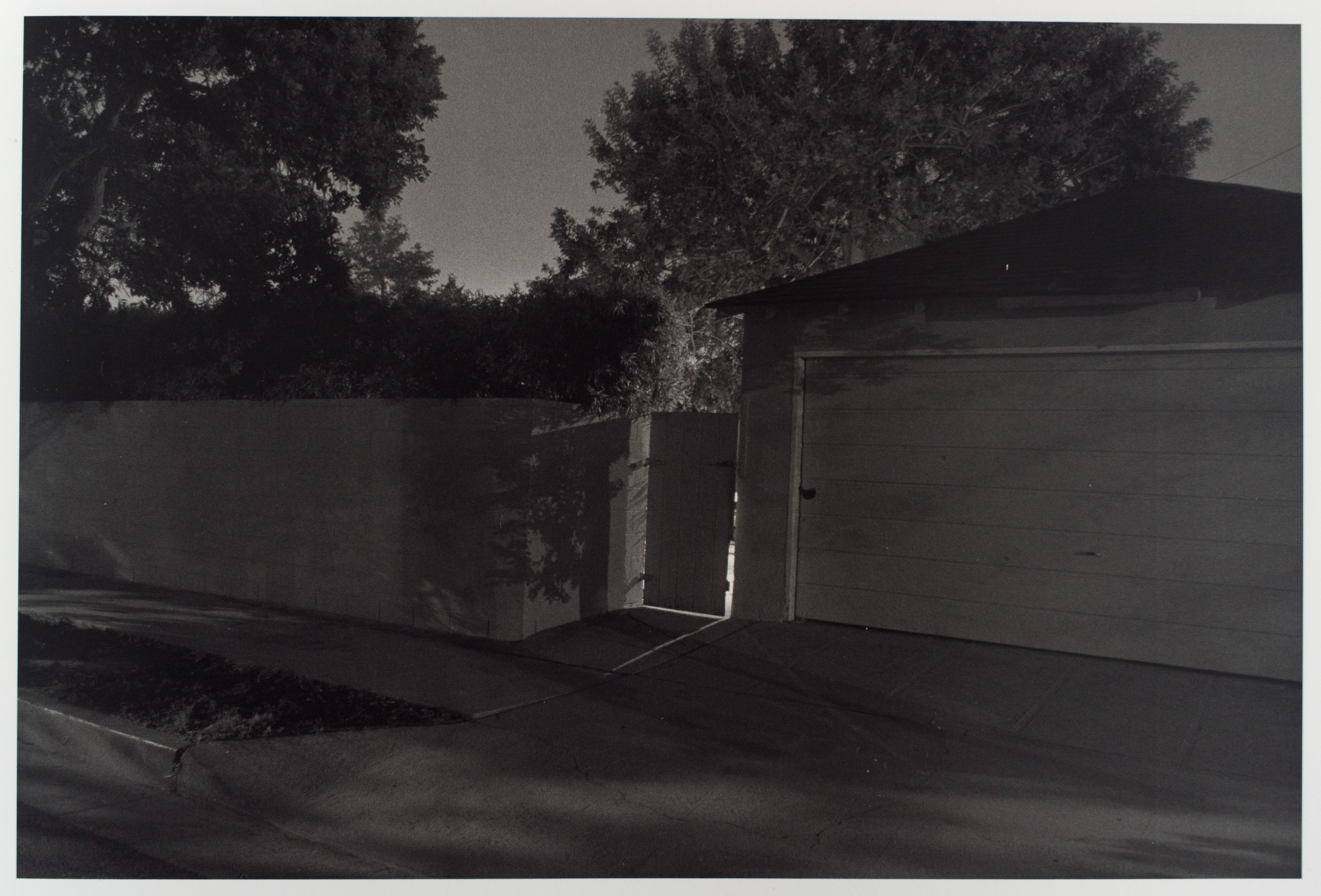
This is from Henry Wessel one of the photographers from the 1975 exhibit at the George Eastman House called The New Topographics. Wessel later did a series of photographs at night in his area of Los Angeles. He says the series began one night, while walking his dog, when he looked up and was struck by the scenes of the streets; later, he would wake up an hour before dawn and walk outside with his camera and tripod, still in a dream state.
I've noticed a compositional affinity in several photographs of my series. This doorway and its cracks of escaping light contrasts with the delicate filtered light on the walls and doors of the majority of the picture. The sky of Los Angeles glows like this on many nights as the streetlight catches the haze, and the little door is an organizing sculptural element. At the end of Wessel's recent book where I found these pictures, is the poem I mentioned, "Anecdote of the Jar" as an epigram.
The New Topographics show brings me to the question of a documentary photograph. While Wessel is definitely documentary, the scenes that struck him were personal, and the framing and compositions not at all dryly objective.
Ed Ruscha made an extended collage of photographs called every building on sunset strip, which he made into a leporello book. His method was flatly mechanical and more objective in feel, but the pictures were also studies for his paintings which blend landscape and mock advertising.
Robert Adams made a beautiful book of a suburb of Denver, Colorado called Summer Nights Walking. The photos therein are documents, but they vary from more objective views of the built environment to much more introspective pictures with obvious subject matter denied. Bernd and Hilla Becher practice a very particular kind of objectivity, and Lewis Baltz's grids of documentary photographs also show dimensions of his personal disposition and outlook. All of the New Topographic photographers have a certain vision and range, even while making documentary photographs.
And today there's google streetview, a form of documentary photography, but executed more like the giant collaboration of a blockbuster film. It's influence is strong.
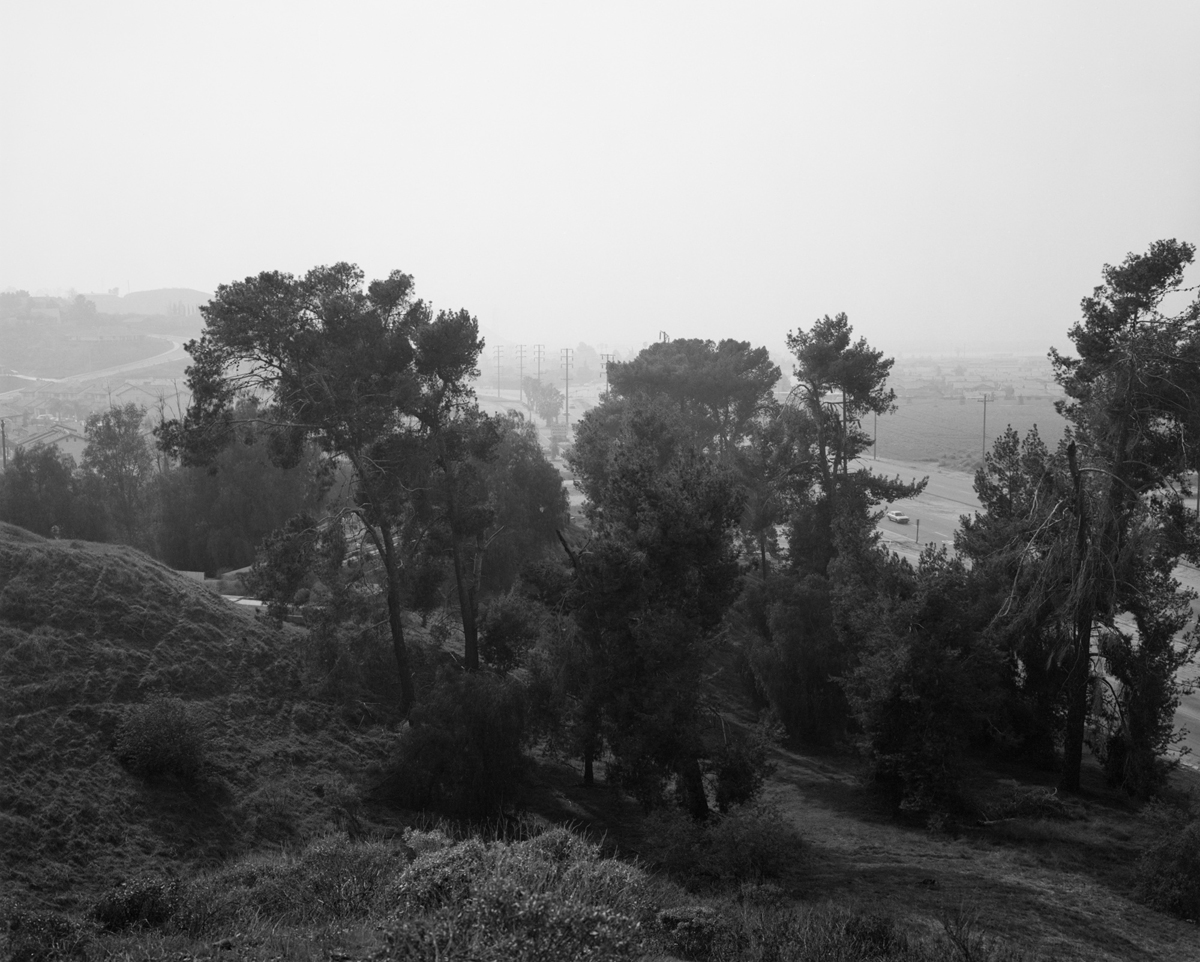
Here's Robert Adams from his book Los Angeles Spring. It's a beautiful book. He has a way of screening his main subject, ecological disaster, with trees and shrubs. Smog is overwhelming the few trees there are. Foreground and background are reversed, in a way from his earlier pictures which have the built environment in the foreground. I like how Robert Adams arranges human and natural elements in his pictures, a critical feel, and a forgiving feel.
I'll go back to another photograph in the series that I think bears some affinity with that Robert Adams.
Here the viewer is standing just past a stand of trees to the right, and just at the edge of a highland marsh pool. This is a pass separating the Connecticut river valley from the Housatonic river valley, and I'm not sure to which valley this water will eventually run. The queen ann's lace is catching the moonlight, as are the waxy leaves. The bright moon is lighting the whole landscape evenly, with the same broad brush sunlight would, giving the picture an echo of daylight, in terms of the light's shape.
The human mark has receded deeply into the picture. A cellular phone tower is visible on the hill, and the road would probably be hidden in the brush if not for the streaking lights of a passing car. In the sky, a streak of light from a passing plane can be seen.
This is not a document of a cell phone tower, exactly, as the viewer is so far removed, but these technologies of telephone and flight and road are parts of some of the great space spanning architectures of mobility. Available to a broad cross section of society, these architectures appear frequently in songs, films, poems, and novels in many ways.
train whistle as space spanning architecture harmonica, guitar, fiddle, vocal
Sounds of Car Radio another space spanning mass media, amplified, car as defacto listening environment,
In this photograph, a lone light hangs over the road, which passes deeper into the picture. The sky curves down through the trees almost to meet it. The blue-green of the light contrasts with the deeper blue of the sky, and catches the nearby leaves. The tar patches follow wandering cracks in the asphalt.
There's also a contrast between the rootedness of lamp post and the moving-on of the ribbon of the road. The David Lynch film Lost Highway shows a road that desperately rushes on ahead. It's that kind of road which the presence of this lamp counter-acts.
The road has economics and politics that are fraught with trouble. These next pictures get to some of those troubles.
Let me not say too much! Or get too political! This picture is from Blacksburg VA. It's hard to know what the owners think they are saying, and if they have any idea how it might look to me.
I'll go on.
In this photograph, just beyond these grasses, shrubs, and small trees is a clearing, and a gleaming new industrial plant of some kind. The emissions curl and billow as the camera exposes, and result in a kind of average spread. The buildings seem new and sparkling in the lights. Trucks come and go even now at 10 or 11pm.
As it turns out this is an installation of a Paris and Houston based company that does a process of natural gas extraction called fracking, but the exact function of this plant is unknown to me.
I think of the Nathaniel Hawthorne short story, Young Goodman Brown, in which the main character, just married, is rushing to a meeting of unknown purpose in a dark wood. A older man meets him on the way and begins to tell him about how he helped his father and grandfather with some rather dark and questionable business in establishing the town. Brown insists he's not like they were, and that he has a good life and lives in a good town. The night gets a bit supernatural on the way, and eventually they come to the edge of a clearing, and in the middle is a huge burning pyre and all the good people of the town are standing before a speaker, firelight flickering on their faces. I'll leave the story there.
But, as I stood next to this clearing I felt a bit like he must have. To me the screen of shrubs is essential, as it gives the viewer a skeptical distance.
Here we have rows of self-storage units just off the road under a few hills with the last light in the western sky overhead. The grass here is showing a late summer burn. These self storage units I think offer another kind of motion. People using these are making a move of some kind, or an improvement, or an experiment. That's the generous version. In many cases, I'm told it's a credit con that ends with the self-storage owner repossessing the contents.
Here the same gas station form is rendered in a new collection of details. The overhead rectangle is familiar, but the brand is unknown. It looks like there could be gas, but the shop looks closed. How often are there stucco apartment buildings with gable roofs clustered around a gas station? It's a place I don't know very well. Those of you who have spent time in Spain may recognize this.
I think as a photographer, working in a different country has a new set of challenges: You have to spend a significant amount of time in a place to get to be able to make good pictures. The surface of life has different implications, different jokes, different connotations, different idioms. How do people feel about a place like this? Do they appreciate the convenience? Is it a newfangled eye-sore? Do kids hang out there? Are there any schools in this rural Spanish town? What kinds of trouble or activity might happen here, and when? who lives up behind the station? It's hard to even have educated guesses about such details, and therefore hard to know what are key details to include in a potential frame.
It's quite a pleasure to make these photographs of sculpture as architecture and to present them to you. Thank you!